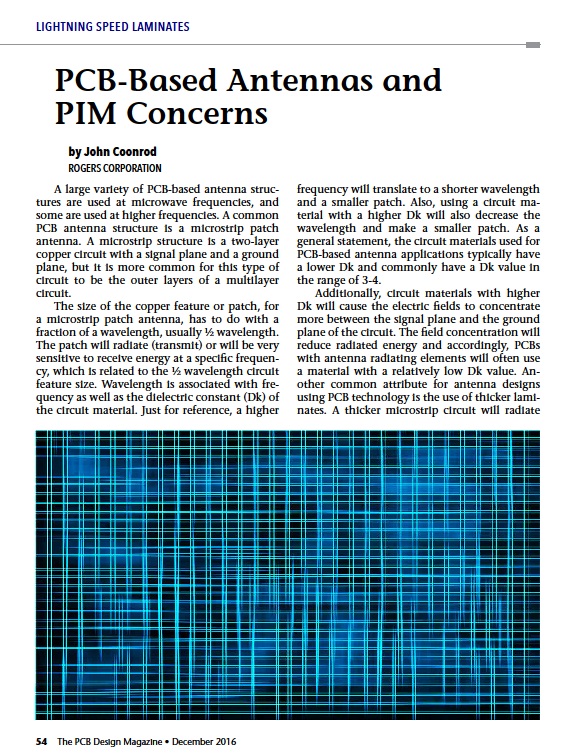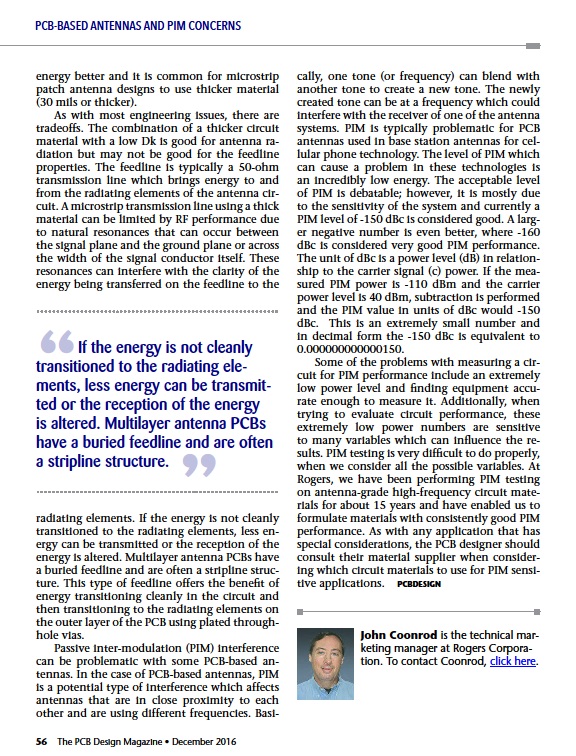PCB-Based Antennas and PIM Concerns
 PCB-Based Antennas and PIM Concerns
PCB-Based Antennas and PIM Concerns
By John Coonrod, technical marketing manager at Rogers Corporation.
Published in The PCB Design Magazine • December 2016
A large variety of PCB-based antenna structures are used at microwave frequencies, and some are used at higher frequencies.
A common PCB antenna structure is a microstrip patch antenna.
A microstrip structure is a two-layer copper circuit with a signal plane and a ground plane, but it is more common for this type of circuit to be the outer layers of a multilayer circuit.
The size of the copper feature or patch, for a microstrip patch antenna, has to do with a fraction of a wavelength, usually ½ wavelength.
The patch will radiate (transmit) or will be very sensitive to receive energy at a specific frequency, which is related to the ½ wavelength circuit feature size.
Wavelength is associated with frequency as well as the dielectric constant (Dk) of the circuit material. Just for reference, a higher frequency will translate to a shorter wavelength and a smaller patch. Also, using a circuit material with a higher Dk will also decrease the wavelength and make a smaller patch. As a general statement, the circuit materials used for PCB-based antenna applications typically have a lower Dk and commonly have a Dk value in the range of 3-4.
Additionally, circuit materials with higher Dk will cause the electric fields to concentrate more between the signal plane and the ground plane of the circuit. The field concentration will reduce radiated energy and accordingly, PCBs with antenna radiating elements will often use a material with a relatively low Dk value. Another common attribute for antenna designs using PCB technology is the use of thicker laminates. A thicker microstrip circuit will radiate energy better and it is common for microstrip patch antenna designs to use thicker material (30 mils or thicker).
As with most engineering issues, there are tradeoffs. The combination of a thicker circuit material with a low Dk is good for antenna radiation but may not be good for the feedline properties. The feedline is typically a 50-ohm transmission line which brings energy to and from the radiating elements of the antenna circuit.
A microstrip transmission line using a thick material can be limited by RF performance due to natural resonances that can occur between the signal plane and the ground plane or across the width of the signal conductor itself. These resonances can interfere with the clarity of the energy being transferred on the feedline to the radiating elements.
If the energy is not cleanly transitioned to the radiating elements, less energy can be transmitted or the reception of the energy is altered. Multilayer antenna PCBs have a buried feedline and are often a stripline structure. This type of feedline offers the benefit of energy transitioning cleanly in the circuit and then transitioning to the radiating elements on the outer layer of the PCB using plated throughhole vias.
Passive inter-modulation (PIM) interference can be problematic with some PCB-based antennas. In the case of PCB-based antennas, PIM is a potential type of interference which affects antennas that are in close proximity to each other and are using different frequencies. Basically, one tone (or frequency) can blend with another tone to create a new tone. The newly created tone can be at a frequency which could interfere with the receiver of one of the antenna systems.
PIM is typically problematic for PCB antennas used in base station antennas for cellular phone technology. The level of PIM which can cause a problem in these technologies is an incredibly low energy. The acceptable level of PIM is debatable; however, it is mostly due to the sensitivity of the system and currently a PIM level of -150 dBc is considered good.
A larger negative number is even better, where -160 dBc is considered very good PIM performance. The unit of dBc is a power level (dB) in relationship to the carrier signal (c) power. If the measured PIM power is -110 dBm and the carrier power level is 40 dBm, subtraction is performed and the PIM value in units of dBc would -150 dBc. This is an extremely small number and in decimal form the -150 dBc is equivalent to 0.000000000000150.
Some of the problems with measuring a circuit for PIM performance include an extremely low power level and finding equipment accurate enough to measure it. Additionally, when trying to evaluate circuit performance, these extremely low power numbers are sensitive to many variables which can influence the results. PIM testing is very difficult to do properly, when we consider all the possible variables.
At Rogers, we have been performing PIM testing on antenna-grade high-frequency circuit materials for about 15 years and have enabled us to formulate materials with consistently good PIM performance. As with any application that has special considerations, the PCB designer should consult their material supplier when considering which circuit materials to use for PIM sensitive applications.



